Research on Hot Stamping-Carbon Partition-Intercritical Annealing Process of Medium Manganese Steel
Abstract
1. Introduction
2. Materials and Methods
3. Experimental Results and Analysis
3.1. Mechanical Performance
3.2. Microstructure
4. Conclusions
- The experimental steel exhibits excellent mechanical properties after the treatment of this new process. The obtained tensile strength is 1184 MPa, the elongation after fracture is 36.8% and the strength-plastic product reaches 43.6 GPa%, which meets the requirement of the third-generation automotive steel. Compared with the QP process and the intercritical annealing process, this newly proposed process obviously enhances the elongation after fracture and contributes to excellent mechanical properties with less difference in tensile strength.
- Multiphase refined microstructure composed of lath martensite, retained austenite, fresh martensite and carbides are obtained by this new process, in which retained austenite is shaped in film by martensitic shear with its volume fraction of 33.7%. In addition, the retained austenite with better stability and higher content gives full play to the TRIP effect, which facilitates the reduction in stress concentration and the improvement of plasticity, and finally contributes to the excellent mechanical properties.
- The austenite reversion is accelerated during the IA process because of the preexisting austenite obtained by the prior QP process. Therefore, the volume fraction of austenite under QA-680 is higher than that under IA-680. Moreover, the transformed fresh martensite after QP process can refine the mixture microstructure of martensite and austenite, resulting in a smaller width of the retained austenite laths. The combining of a higher volume fraction of retained austenite and refiner microstructure promotes the improvement of mechanical properties.
Author Contributions
Funding
Institutional Review Board Statement
Informed Consent Statement
Data Availability Statement
Acknowledgments
Conflicts of Interest
References
- Zhang, W.; Xu, J. Advanced lightweight materials for Automobiles: A review. Mater. Des. 2022, 221, 110994. [Google Scholar] [CrossRef]
- Kantanen, P.; Anttila, S.; Karjalainen, P.; Latypova, R.; Somani, M.; Kaijalainen, A.; Kömi, J. Microstructures and mechanical properties of three medium-Mn steels processed via quenching and partitioning as well as austenite reversion heat treatments. Mater. Sci. Eng. A 2022, 847, 143341. [Google Scholar] [CrossRef]
- Cavusoglu, O.; Cavusoglu, O.; Yilmazoglu, A.G.; Üzel, U.; Aydın, H.; Güral, A. Microstructural features and mechanical properties of 22MnB5 hot stamping steel in different heat treatment conditions. J. Mater. Res. Technol. 2020, 9, 10901–10908. [Google Scholar] [CrossRef]
- Zhang, X.; Jia, Z.; Liu, T.; Shi, Y.; Liu, H.; Wang, X.; Wang, Y.; Liu, X.; Zhou, Q. Enhancing the strength–ductility synergy of medium-Mn steel by introducing multiple gra-dient structures. Mater. Sci. Eng. A 2022, 860, 144268. [Google Scholar] [CrossRef]
- Chang, Y.; Wang, C.; Zhao, K.; Dong, H.; Yan, J. An Introduction to Medium-Mn Steel: Metallurgy, Mechanical Properties and Warm Stamping Process. Mater. Des. 2016, 94, 424–432. [Google Scholar] [CrossRef]
- Karbasian, H.; Tekkaya, A.E. A review on hot stamping. J. Mater. Process. Technol. 2010, 210, 2103–2118. [Google Scholar] [CrossRef]
- Wang, Z.; Zhang, Y.; Zhu, B.; Wang, Y.; Ding, H.; Cai, M. Hot stamped parts with desirable properties in medium Mn TRIP steels. Procedia Eng. 2017, 207, 699–704. [Google Scholar] [CrossRef]
- Tong, C.; Zhu, G.; Rong, Q.; Yardley, V.A.; Shi, Z.; Li, X.; Luo, J.; Lin, J. Investigation of austenitising behaviour of medium-Mn steel in the hot-stamping heating process. J. Mater. Process. Technol. 2021, 297, 117269. [Google Scholar] [CrossRef]
- Tsuchiyama, T.; Inoue, T.; Tobata, J.; Akama, D.; Takaki, S. Microstructure and mechanical properties of a medium manganese steel treated with interrupted quenching and intercritical annealing. Scr. Mater. 2016, 122, 36–39. [Google Scholar] [CrossRef]
- Zou, Y.; Xu, Y.B.; Hu, Z.P.; Gu, X.L.; Peng, F.; Tan, X.D.; Chen, S.Q.; Han, D.T.; Misra, R.D.K.; Wang, G.D. Austenite stability and its effect on the toughness of a high strength ultra-low carbon medium manganese steel plate. Mater. Sci. Eng. A 2016, 675, 153–163. [Google Scholar] [CrossRef]
- Liu, H.; Du, L.X.; Hu, J.; Wu, H.; Gao, X.; Misra, R. Interplay Between Reversed Austenite and Plastic Deformation in a Directly Quenched and Intercritically Annealed 0.04C-5Mn Low-Al Steel. J. Alloy. Compd. 2017, 695, 2072–2082. [Google Scholar] [CrossRef]
- Xu, Z.Y. Proposal to apply quenching-carbon partition-tempering and plastic forming integration technology to Trip steel. Heat Treat. 2010, 25, 1–5. [Google Scholar]
- Han, X.; Li, Y.; Chen, S.; Tan, S.; Ding, Y.; Chen, J. Research On Q&P Hot Stamping Process Integrated with Fractional Cooling Strategy. Procedia Eng. 2017, 207, 705–710. [Google Scholar]
- Ariza, E.A.; Masoumi, M.; Tschiptschin, A.P. Improvement of Tensile Mechanical Properties in a Trip-Assisted Steel by Con-trolling of Crystallographic Orientation Via Hsq&P Processes. Mater. Sci. Eng. A 2018, 713, 223–233. [Google Scholar]
- Ariza, E.A.; Nishikawa, A.S.; Goldenstein, H.; Tschiptschin, A.P. Characterization and Methodology for Calculating the Mechanical Properties of a Trip-Steel Submitted to Hot Stamping and Quenching and Partitioning (Q&P). Mater. Sci. Eng. A 2016, 671, 54–69. [Google Scholar]
- Hu, B.; Luo, H.W. A novel two-step intercritical annealing process to improve mechanical properties of medium Mn steel. Acta Mater. 2019, 176, 250–263. [Google Scholar] [CrossRef]
- Zhou, W.; Wang, X.; Venkatsurya, P.; Guo, H.; Shang, C.; Misra, R. Structure-mechanical property relationship in a high strength low carbon alloy steel processed by two-step intercritical annealing and intercritical tempering. Mater. Sci. Eng. A 2014, 607, 569–577. [Google Scholar] [CrossRef]
- Speer, J.; Matlock, D.K.; De Cooman, B.C.; Schroth, J.G. Carbon partitioning into austenite after martensite transformation. Acta Mater. 2003, 51, 2611–2622. [Google Scholar] [CrossRef]
- Pierce, D.; Coughlin, D.; Williamson, D.; Kähkönen, J.; Clarke, A.; Clarke, K.; Speer, J.; De Moor, E. Quantitative investigation into the influence of temperature on carbide and austenite evolution during partitioning of a quenched and partitioned steel. Scr. Mater. 2016, 121, 5–9. [Google Scholar] [CrossRef]
- Cai, Z.H.; Ding, H.; Misra, R.; Ying, Z.Y. Austenite stability and deformation behavior in a cold-rolled transformation-induced plas-ticity steel with medium manganese content. Acta Mater. 2015, 84, 229–236. [Google Scholar] [CrossRef]
- Li, J.J.; Song, R.B.; Li, X.; Zhou, N.; Song, R. Microstructural evolution and tensile properties of 70 GPa·% grade strongand ductile hot-rolled 6Mn steel treated by intercritical annealing. Mater. Sci. Eng. A 2019, 745, 212–220. [Google Scholar] [CrossRef]
- Wan, X.H.; Liu, G.; Yang, Z.G.; Chen, H. Flash annealing yields a strong and ductile medium Mn steel with heterogeneous micro-structure. Scr. Mater. 2021, 198, 113819. [Google Scholar] [CrossRef]
- Li, J.; Xu, Y.; Lu, B.; Yu, Y.; Jing, Y.; Sun, W. Improvement of strength-ductility combination in ultra-high-strength medium-Mn Q&P steel by tailoring the characteristics of martensite/retained austenite constituents. J. Mater. Res. Technol. 2022, 18, 352–369. [Google Scholar]
- Hu, B.; Zheng, Q.; Lu, Y.; Jia, C.; Liang, T.; Zheng, C.; Li, D. Stabilizing austenite via intercritical Mn partitioning in a medium Mn steel. Scr. Mater. 2023, 225, 115167. [Google Scholar] [CrossRef]
- Xu, X.; Kwok, T.W.J.; Gong, P.; Dye, D. Tailoring the deformation behaviour of a medium Mn steel through isothermal intercritical annealing. Materialia 2022, 22, 101422. [Google Scholar] [CrossRef]
- Jing, S.Y.; Ding, H.; Ren, Y.P.; Cai, Z. A new insight into annealing parameters in tailoring the mechanicalproperties of a medium Mn steel. Scr. Mater. 2021, 202, 114019. [Google Scholar] [CrossRef]
- He, B.B.; Pan, S.; Huang, M.X. Extra work hardening in room-temperature quenching and partitioning medium Mn steel enabled by intercritical annealing. Mater. Sci. Eng. A 2020, 797, 140106. [Google Scholar] [CrossRef]
- Yan, S.; Li, T.; Liang, T.; Liu, X. Adjusting the microstructure evolution, mechanical properties and deformation behaviors of Fe-5.95Mn-1.55Si-1.03Al-0.055C medium Mn steel by cold-rolling reduction ratio. J. Mater. Res. Technol. 2020, 9, 1314–1324. [Google Scholar] [CrossRef]
- Bai, S.-B.; Xiao, W.-T.; Niu, W.-Q.; Wang, Y.-D.; Li, D.-Z.; Zhang, W.-G.; Shi, Q.-X.; Liang, W. Microstructural evolution and mechanical properties of V-containing medium-Mn steel manufactured via cold rolling and intercritical annealing. J. Mater. Res. Technol. 2021, 14, 1504–1517. [Google Scholar] [CrossRef]
- Hao, L.; Ji, X.; Zhang, G.; Zhao, W.; Sun, M.; Peng, Y. Carbide precipitation behavior and mechanical properties of micro-alloyed medium Mn steel. J. Mater. Res. Technol. 2020, 47, 122–130. [Google Scholar] [CrossRef]
- Yan, N.; Di, H.; Misra, R.; Huang, H.; Li, Y. Enhancing austenite stability in a new medium-Mn steel by combining deep cryogenic treatment and intercritical annealing: An experimental and theoretical study. Mater. Sci. Eng. A 2019, 753, 11–21. [Google Scholar] [CrossRef]
- Jeong, M.S.; Park, T.M.; Choi, S.; Lee, S.-J.; Han, J. Recovering the ductility of medium-Mn steel by restoring the original microstructure. Scr. Mater. 2021, 190, 16–21. [Google Scholar] [CrossRef]
- Ding, R.; Dai, Z.; Huang, M.; Yang, Z.; Zhang, C.; Chen, H. Effect of pre-existed austenite on austenite reversion and mechanical behavior of an Fe–0.2C–8Mn–2Al medium Mn steel. Acta Mater. 2018, 147, 59–69. [Google Scholar] [CrossRef]
- Han, D.T.; Xu, Y.B.; Peng, F.; Zou, Y.; Misra, R.D.K. The determining role of pre-annealing on Mn partitioning behavior in medium-Mn-TRIP steel: Experimental and numerical simulation. Met. Corros. 2020, 55, 4437–4452. [Google Scholar] [CrossRef]
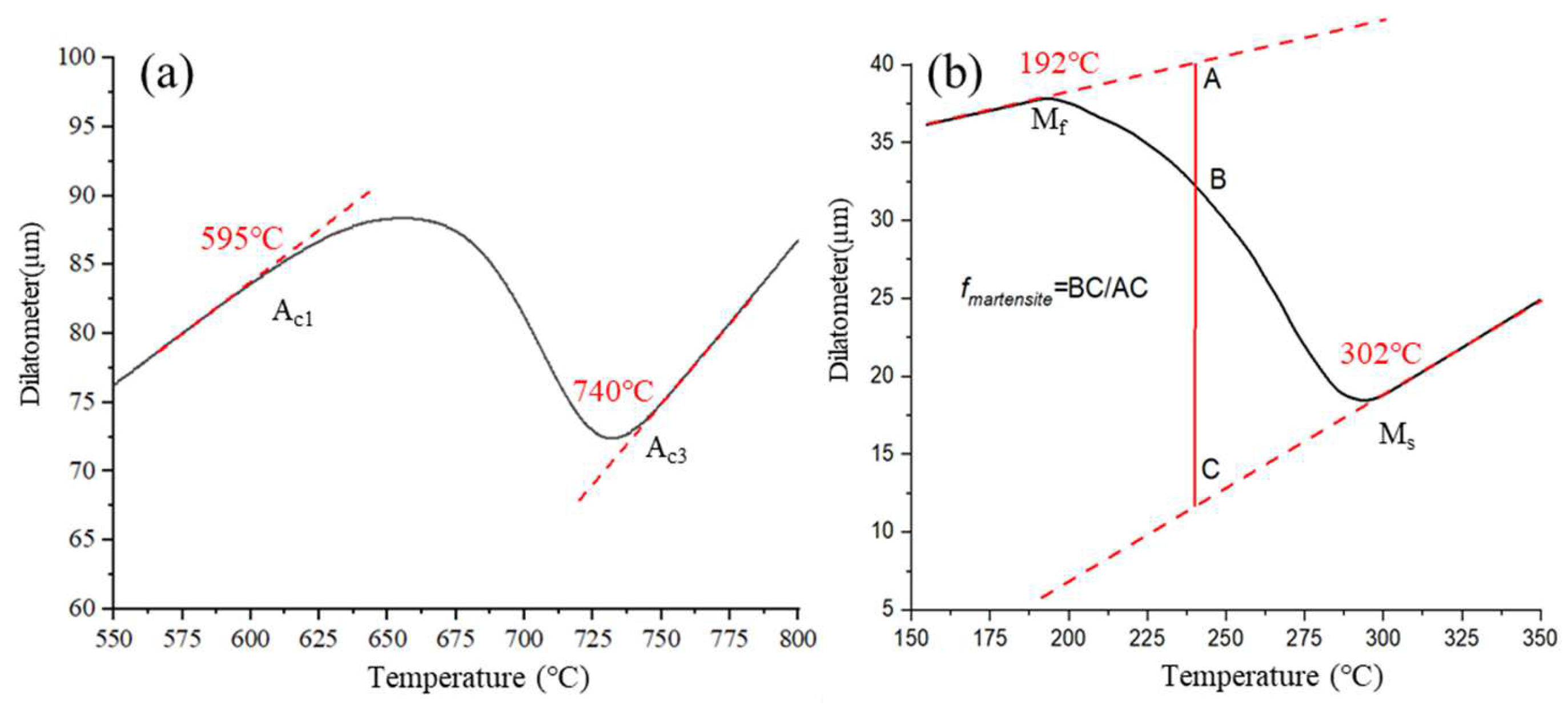
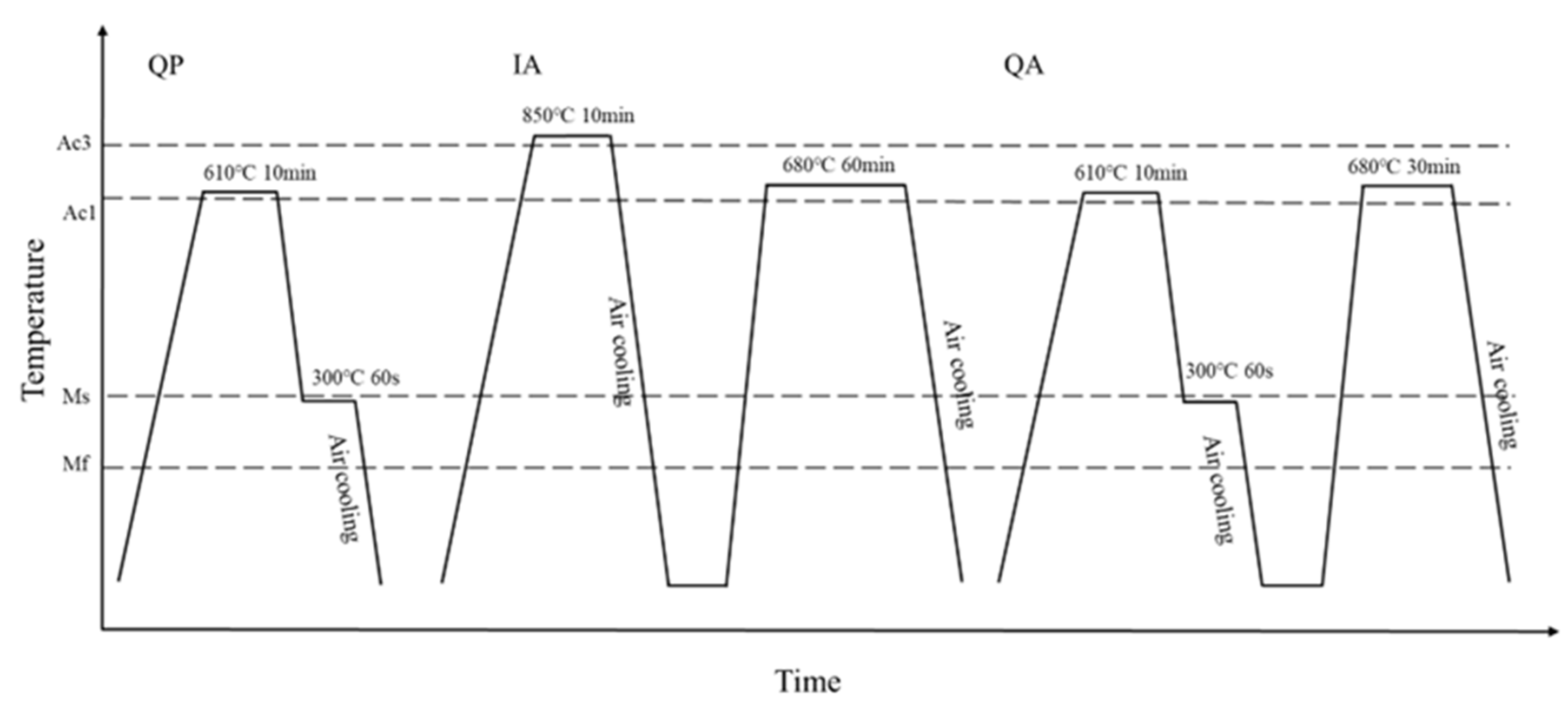
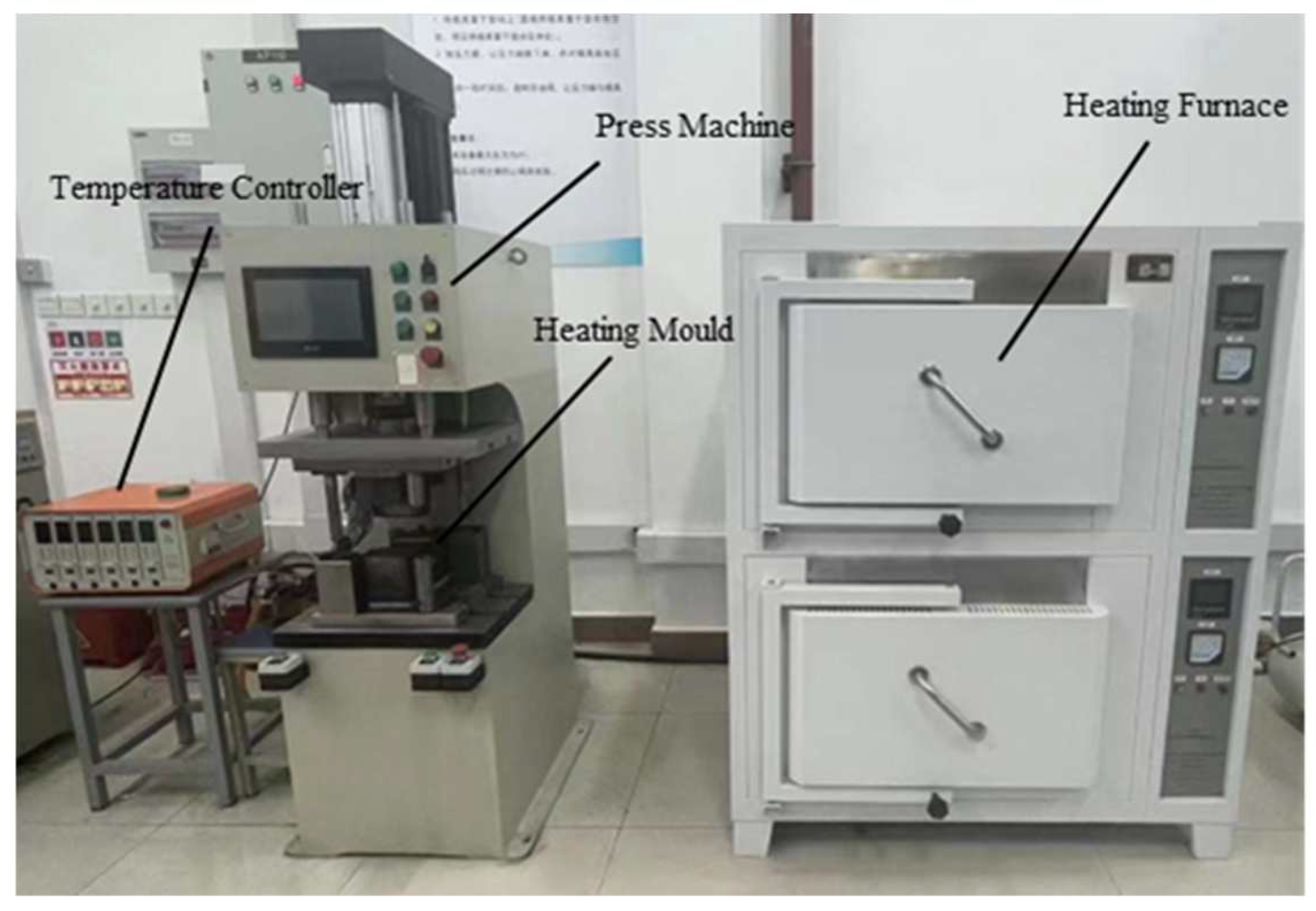
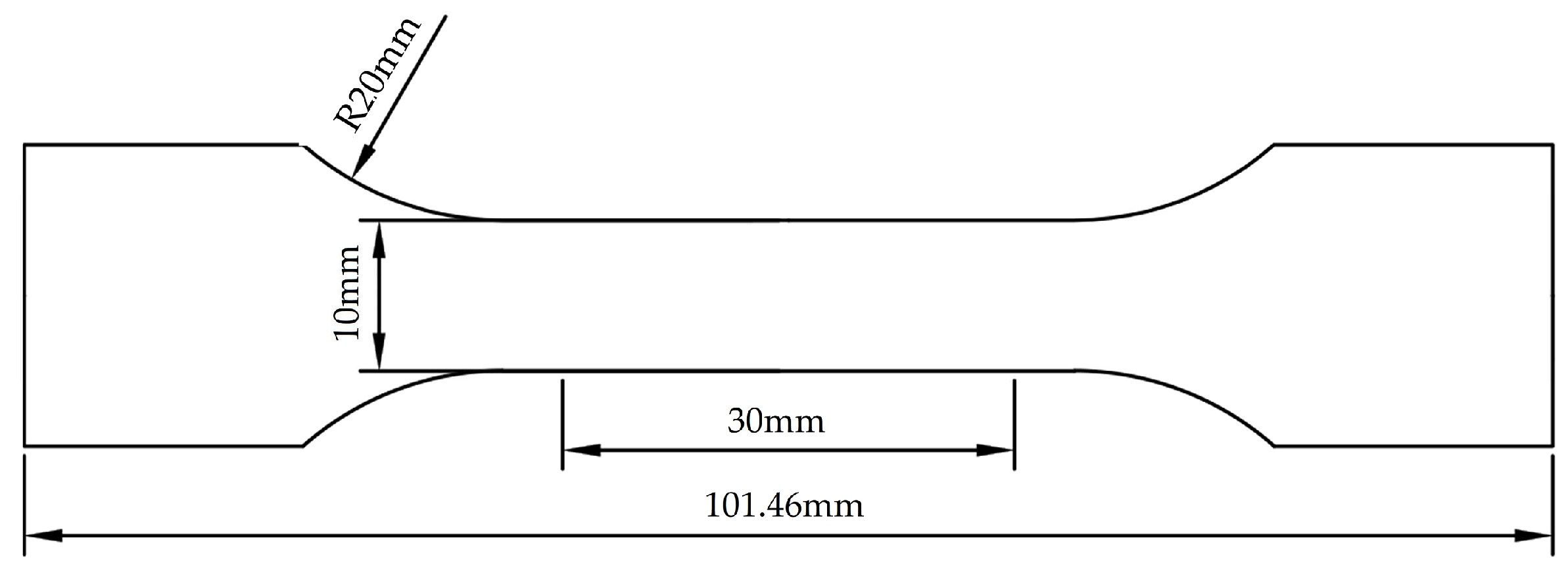
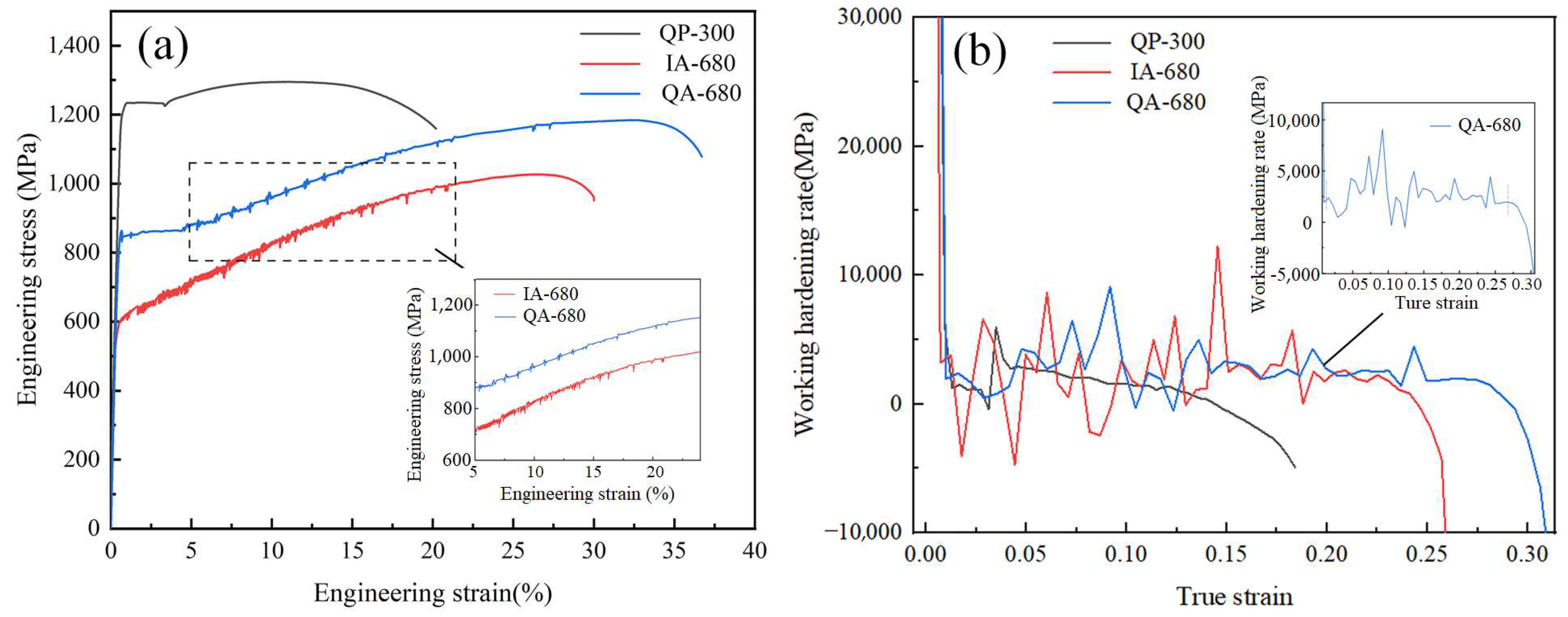
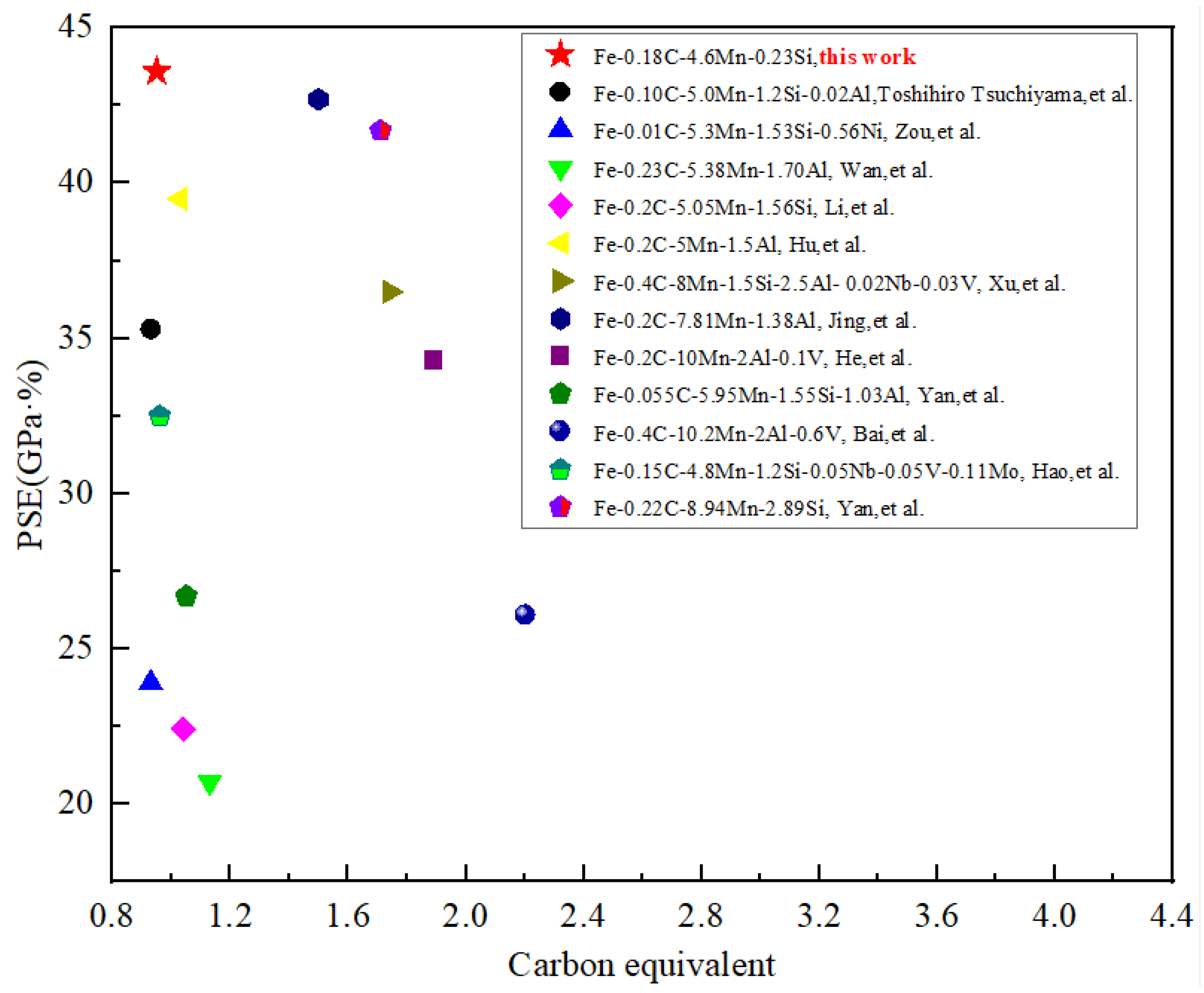
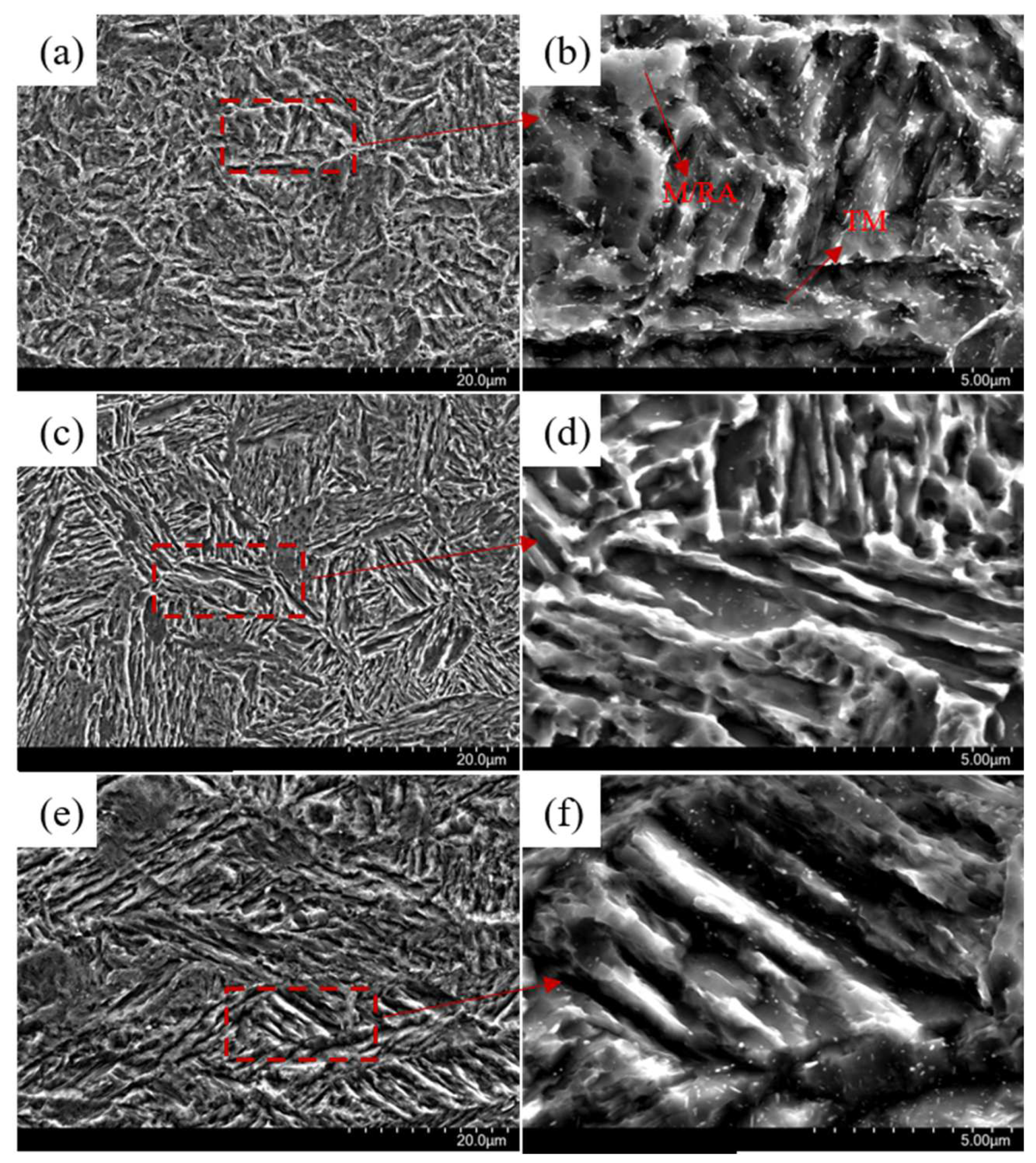
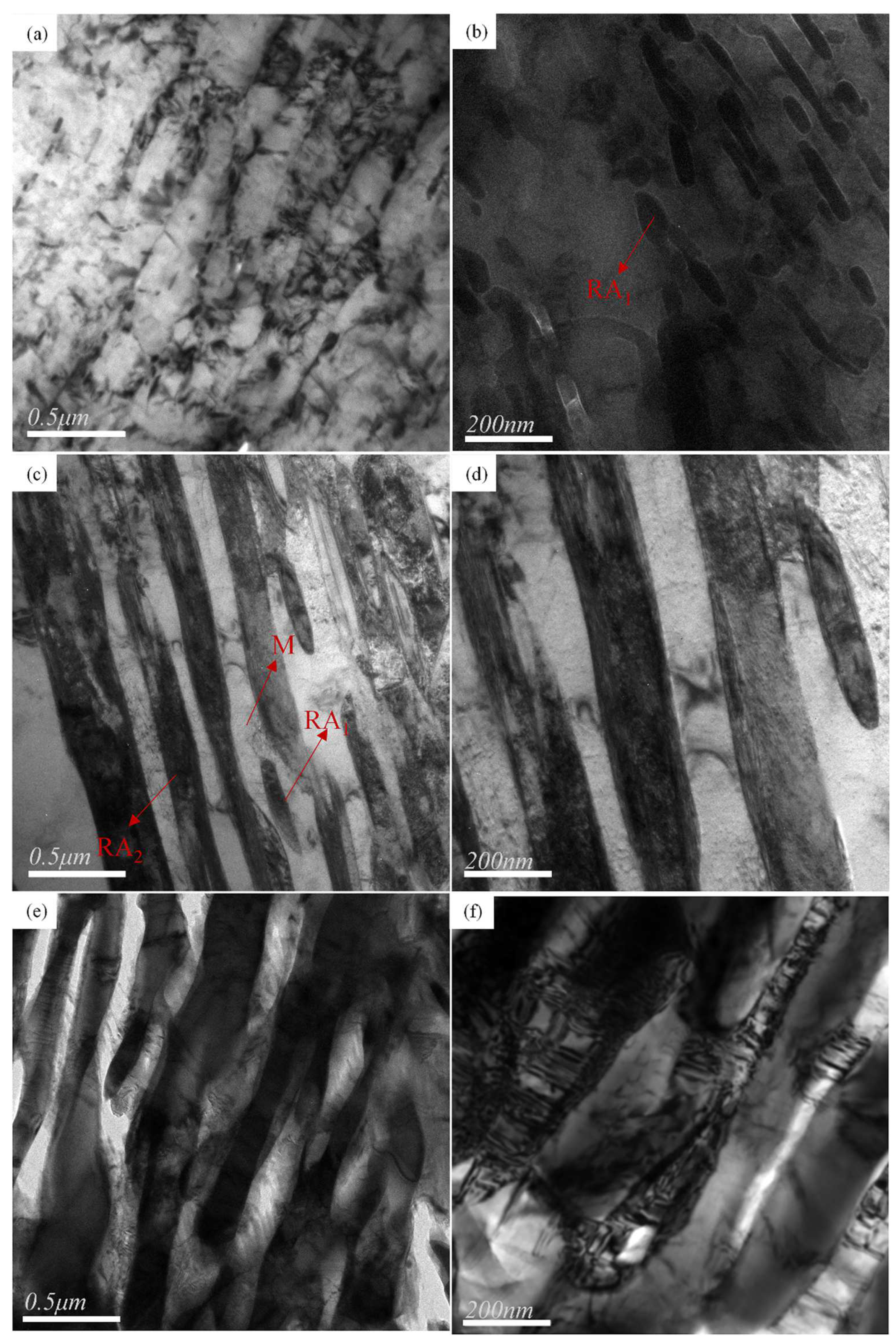
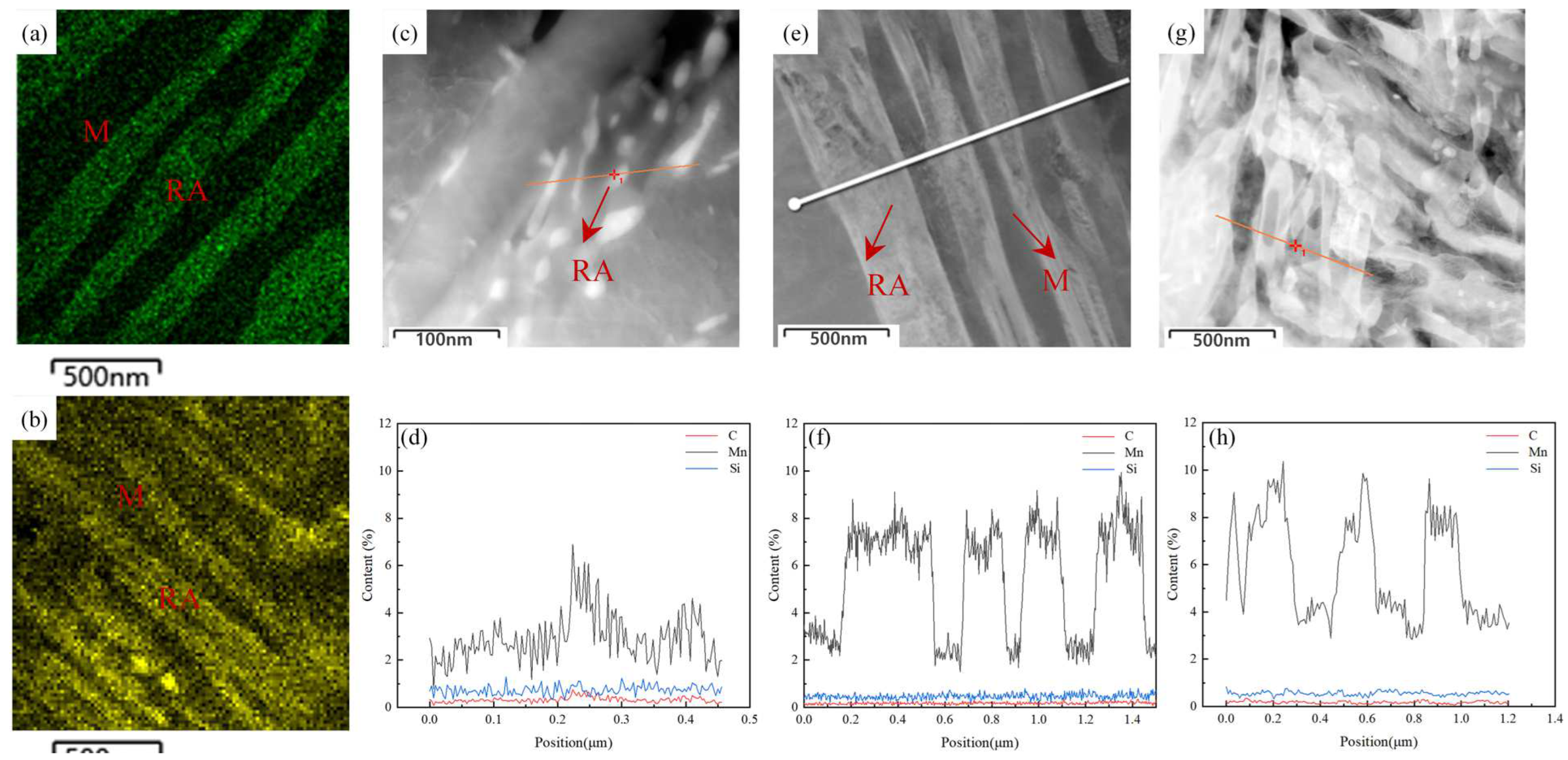
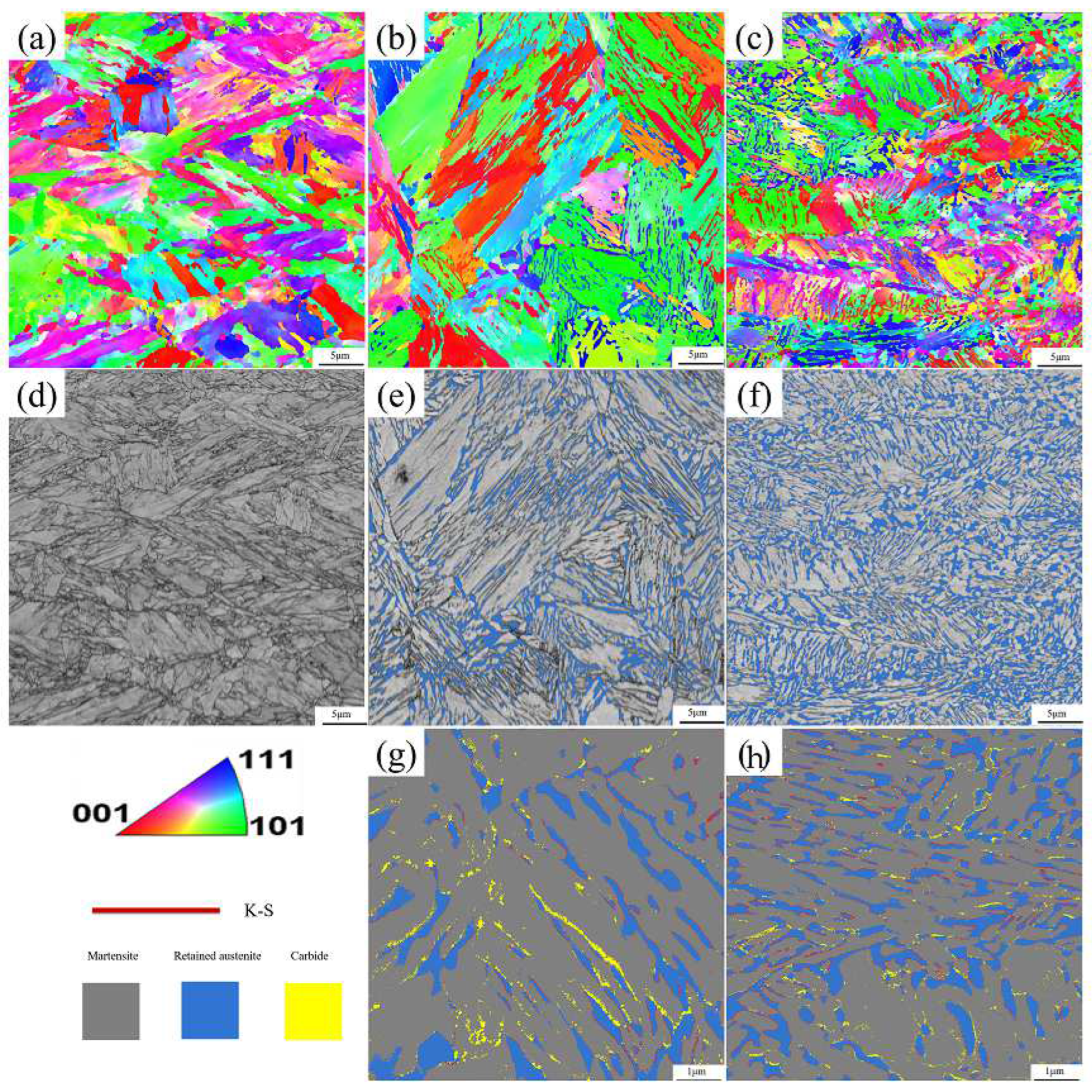
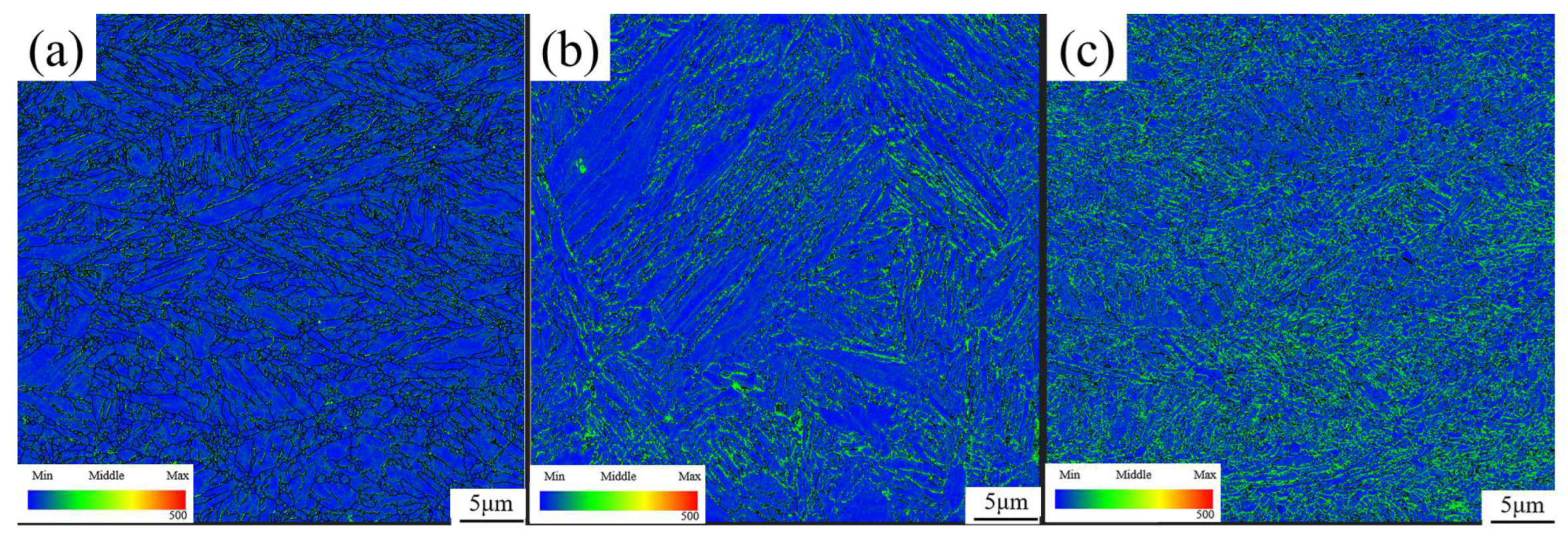
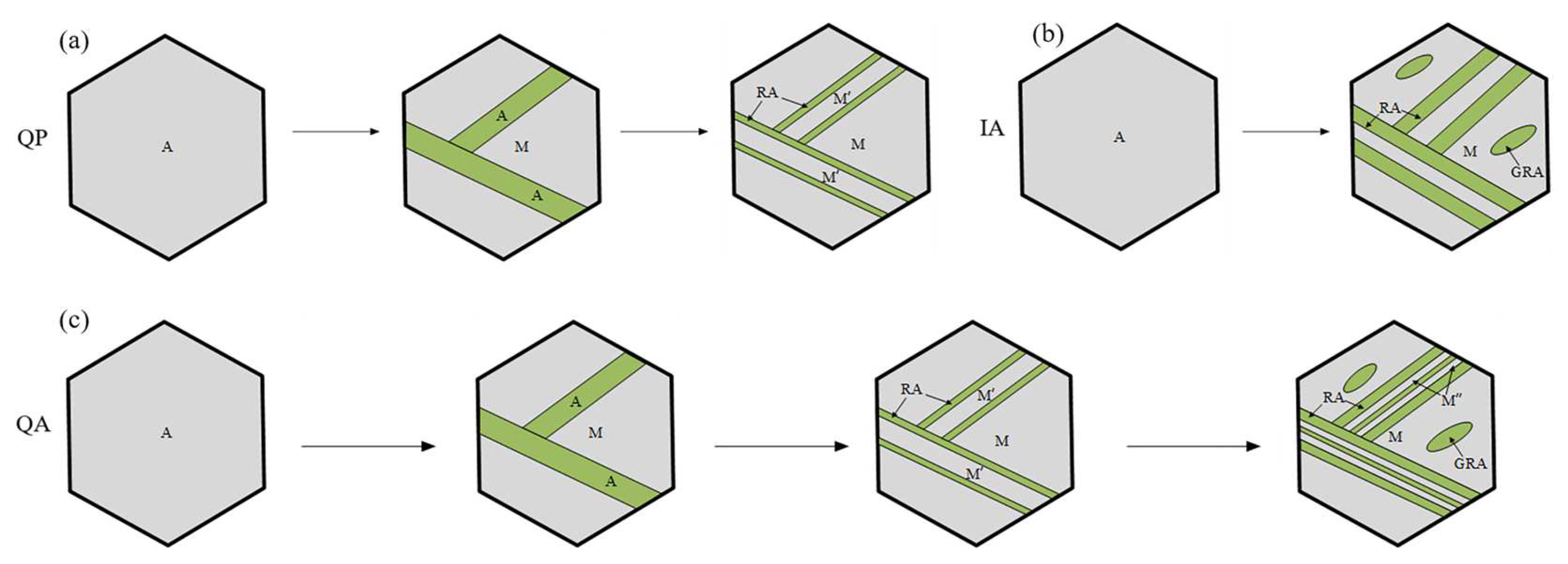
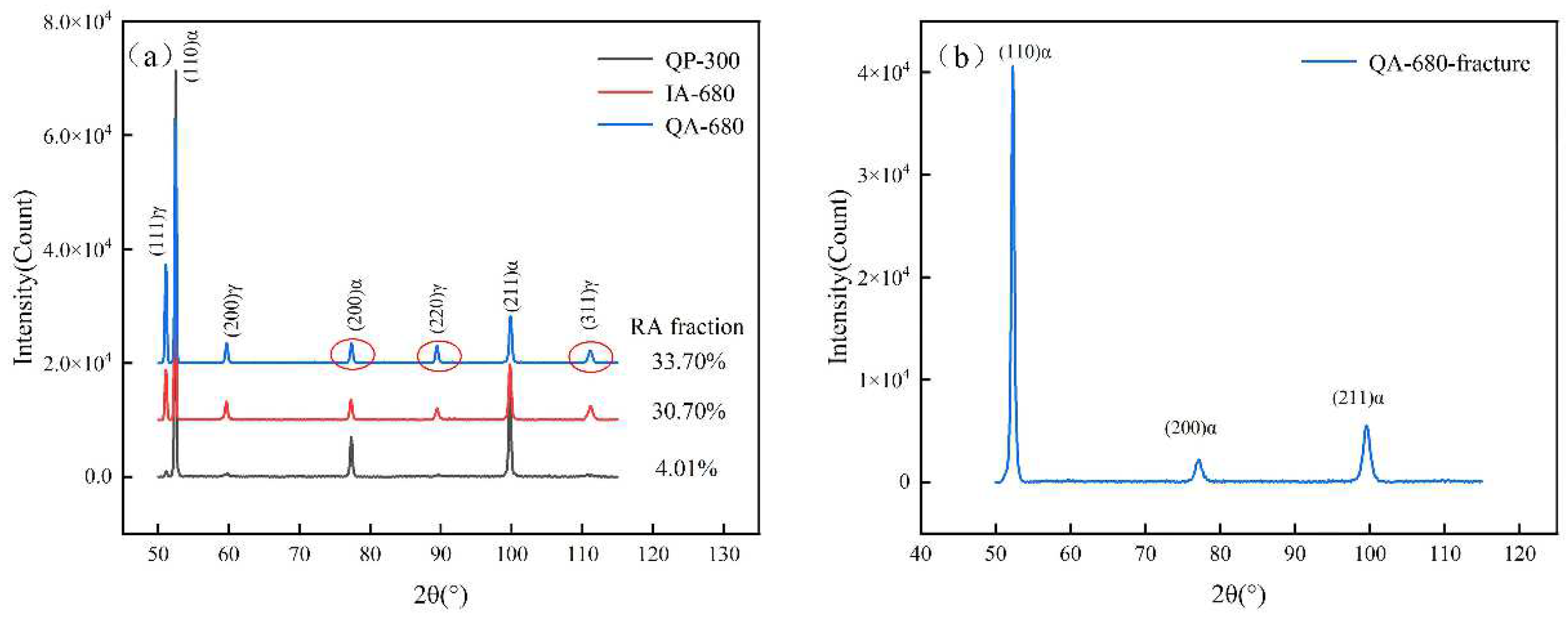
| C | Mn | Si | S | P | N | Fe |
|---|---|---|---|---|---|---|
| 0.18 | 4.6 | 0.23 | 0.005 | 0.0182 | 0.0055 | Bal. |
| UST(MPa) | TEL(%) | PSE (GPa%) | |
|---|---|---|---|
| QP-300 | 1295 | 20.2 | 26.2 |
| IA-680 | 1027 | 30.0 | 30.8 |
| QA-680 | 1184 | 36.8 | 43.6 |
Disclaimer/Publisher’s Note: The statements, opinions and data contained in all publications are solely those of the individual author(s) and contributor(s) and not of MDPI and/or the editor(s). MDPI and/or the editor(s) disclaim responsibility for any injury to people or property resulting from any ideas, methods, instructions or products referred to in the content. |
© 2023 by the authors. Licensee MDPI, Basel, Switzerland. This article is an open access article distributed under the terms and conditions of the Creative Commons Attribution (CC BY) license (https://creativecommons.org/licenses/by/4.0/).
Share and Cite
Wang, Z.; Guo, X.; Ding, H.; Zhang, Y.; Xiang, C. Research on Hot Stamping-Carbon Partition-Intercritical Annealing Process of Medium Manganese Steel. Materials 2023, 16, 576. https://doi.org/10.3390/ma16020576
Wang Z, Guo X, Ding H, Zhang Y, Xiang C. Research on Hot Stamping-Carbon Partition-Intercritical Annealing Process of Medium Manganese Steel. Materials. 2023; 16(2):576. https://doi.org/10.3390/ma16020576
Chicago/Turabian StyleWang, Zijian, Xiaoming Guo, Hanlin Ding, Yisheng Zhang, and Chongchen Xiang. 2023. "Research on Hot Stamping-Carbon Partition-Intercritical Annealing Process of Medium Manganese Steel" Materials 16, no. 2: 576. https://doi.org/10.3390/ma16020576
APA StyleWang, Z., Guo, X., Ding, H., Zhang, Y., & Xiang, C. (2023). Research on Hot Stamping-Carbon Partition-Intercritical Annealing Process of Medium Manganese Steel. Materials, 16(2), 576. https://doi.org/10.3390/ma16020576






